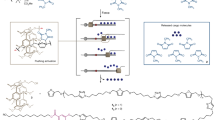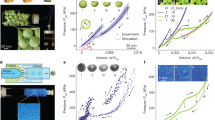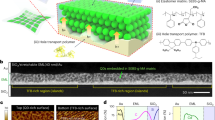Abstract
Microorganisms move in challenging environments by periodic changes in body shape. In contrast, current artificial microrobots cannot actively deform, exhibiting at best passive bending under external fields. Here, by taking advantage of the wireless, scalable and spatiotemporally selective capabilities that light allows, we show that soft microrobots consisting of photoactive liquid-crystal elastomers can be driven by structured monochromatic light to perform sophisticated biomimetic motions. We realize continuum yet selectively addressable artificial microswimmers that generate travelling-wave motions to self-propel without external forces or torques, as well as microrobots capable of versatile locomotion behaviours on demand. Both theoretical predictions and experimental results confirm that multiple gaits, mimicking either symplectic or antiplectic metachrony of ciliate protozoa, can be achieved with single microswimmers. The principle of using structured light can be extended to other applications that require microscale actuation with sophisticated spatiotemporal coordination for advanced microrobotic technologies.
This is a preview of subscription content, access via your institution
Access options
Subscribe to this journal
Receive 12 print issues and online access
$259.00 per year
only $21.58 per issue
Buy this article
- Purchase on Springer Link
- Instant access to full article PDF
Prices may be subject to local taxes which are calculated during checkout




Similar content being viewed by others
References
Nelson, B. J., Kaliakatsos, I. K. & Abbott, J. J. Microrobots for minimally invasive medicine. Annu. Rev. Biomed. Eng. 12, 55–85 (2010).
Sitti, M. et al. Biomedical applications of untethered mobile milli/microrobots. Proc. IEEE 103, 205–224 (2015).
Purcell, E. M. Life at low Reynolds number. Am. J. Phys. 45, 3–11 (1977).
Lauga, E. & Powers, T. R. The hydrodynamics of swimming microorganisms. Rep. Prog. Phys. 72, 96601 (2009).
Elgeti, J. & Gompper, G. Emergence of metachronal waves in cilia arrays. Proc. Natl Acad. Sci. USA 110, 4470–4475 (2013).
Choi, H. et al. Two-dimensional locomotion of a microrobot with a novel stationary electromagnetic actuation system. Smart Mater. Struct. 18, 115017 (2009).
Kummer, M. P. et al. OctoMag: an electromagnetic system for 5-DOF wireless micromanipulation. IEEE Trans. Robot. 26, 1006–1017 (2010).
Fischer, P. & Ghosh, A. Magnetically actuated propulsion at low Reynolds numbers: towards nanoscale control. Nanoscale 3, 557–563 (2011).
Palagi, S., Mazzolai, B., Innocenti, C., Sangregorio, C. & Beccai, L. How does buoyancy of hydrogel microrobots affect their magnetic propulsion in liquids? Appl. Phys. Lett. 102, 124102–124105 (2013).
Shields, A. R. et al. Biomimetic cilia arrays generate simultaneous pumping and mixing regimes. Proc. Natl Acad. Sci. USA 107, 15670–15675 (2010).
Donald, B. R., Levey, C. G., McGray, C. D., Paprotny, I. & Rus, D. An untethered, electrostatic, globally controllable MEMS micro-robot. J. Microelectromech. Syst. 15, 1–15 (2006).
Hu, W., Ishii, K. S. & Ohta, A. T. Micro-assembly using optically controlled bubble microrobots. Appl. Phys. Lett. 99, 94103 (2011).
van Oosten, C. L., Bastiaansen, C. W. M. & Broer, D. J. Printed artificial cilia from liquid-crystal network actuators modularly driven by light. Nature Mater. 8, 677–682 (2009).
Diller, E., Zhuang, J., Zhan Lum, G., Edwards, M. R. & Sitti, M. Continuously distributed magnetization profile for millimeter-scale elastomeric undulatory swimming. Appl. Phys. Lett. 104, 174101 (2014).
Sánchez, S., Soler, L. & Katuri, J. Chemically powered micro- and nanomotors. Angew. Chem. Int. Ed. 54, 1414–1444 (2015).
Schamel, D. et al. Nanopropellers and their actuation in complex viscoelastic media. ACS Nano 8, 8794–8801 (2014).
Iacovacci, V. et al. Untethered magnetic millirobot for targeted drug delivery. Biomed. Microdevices 17, 1–12 (2015).
Servant, A., Qiu, F., Mazza, M., Kostarelos, K. & Nelson, B. J. Controlled in vivo swimming of a swarm of bacteria-like microrobotic flagella. Adv. Mater. 27, 2981–2988 (2015).
Snezhko, A., Belkin, M., Aranson, I. S. & Kwok, W. K. Self-assembled magnetic surface swimmers. Phys. Rev. Lett. 102, 118103 (2009).
Snezhko, A. & Aranson, I. S. Magnetic manipulation of self-assembled colloidal asters. Nature Mater. 10, 698–703 (2011).
Dreyfus, R. et al. Microscopic artificial swimmers. Nature 437, 862–865 (2005).
Qiu, T. et al. Swimming by reciprocal motion at low Reynolds number. Nature Commun. 5, 5119 (2014).
Majidi, C. Soft robotics: a perspective—current trends and prospects for the future. Soft Robot. 1, 5–11 (2013).
Kim, S., Laschi, C. & Trimmer, B. Soft robotics: a bioinspired evolution in robotics. Trends Biotechnol. 31, 287–294 (2013).
Laschi, C. & Cianchetti, M. Soft robotics: new perspectives for robot bodyware and control. Front. Bioeng. Biotechnol. 2, 3 (2014).
Rus, D. & Tolley, M. T. Design, fabrication and control of soft robots. Nature 521, 467–475 (2015).
Ranzani, T., Gerboni, G., Cianchetti, M. & Menciassi, A. A bioinspired soft manipulator for minimally invasive surgery. Bioinspir. Biomim. 10, 035008 (2015).
Bartlett, N. W. et al. A 3D-printed, functionally graded soft robot powered by combustion. Science 349, 161–165 (2015).
Hauser, A. W., Evans, A. A., Na, J.-H. & Hayward, R. C. Photothermally reprogrammable buckling of nanocomposite gel sheets. Angew. Chem. Int. Ed. 54, 5434–5437 (2015).
Tabatabaei, S. N., Lapointe, J. & Martel, S. Shrinkable hydrogel-based magnetic microrobots for interventions in the vascular network. Adv. Robot. 25, 1049–1067 (2011).
Fusco, S. et al. An integrated microrobotic platform for on-demand, targeted therapeutic interventions. Adv. Mater. 26, 952–957 (2014).
Zeng, H. et al. Light-fueled microscopic walkers. Adv. Mater. 27, 3883–3887 (2015).
Warner, M. & Terentjev, E. M. Liquid Crystal Elastomers Vol. 120 (Oxford Univ. Press, 2003).
Ohm, C., Brehmer, M. & Zentel, R. Liquid crystalline elastomers as actuators and sensors. Adv. Mater. 22, 3366–3387 (2010).
Fleischmann, E.-K. et al. One-piece micropumps from liquid crystalline core-shell particles. Nature Commun. 3, 1178 (2012).
Fleischmann, E.-K., Forst, F. R. & Zentel, R. Liquid-crystalline elastomer fibers prepared in a microfluidic device. Macromol. Chem. Phys. 215, 1004–1011 (2014).
Camacho-Lopez, M., Finkelmann, H., Palffy-Muhoray, P. & Shelley, M. Fast liquid-crystal elastomer swims into the dark. Nature Mater. 3, 307–310 (2004).
Wang, L. et al. A bioinspired swimming and walking hydrogel driven by light-controlled local density. Adv. Sci. 2, 1500084 (2015).
Uchida, E., Azumi, R. & Norikane, Y. Light-induced crawling of crystals on a glass surface. Nature Commun. 6, 7310 (2015).
Khatavkar, V. V., Anderson, P. D., den Toonder, J. M. J. & Meijer, H. E. H. Active micromixer based on artificial cilia. Phys. Fluids 19, 083605 (2007).
Taylor, G. Analysis of the swimming of microscopic organisms. Proc. R. Soc. Lond. A 209, 447–461 (1951).
Taylor, G. The action of waving cylindrical tails in propelling microscopic organisms. Proc. R. Soc. Lond. A 211, 225–239 (1952).
Knight-Jones, E. W. Relations between metachronism and the direction of ciliary beat in Metazoa. J. Cell Sci. s3-95, 503–521 (1954).
Childress, S. Mechanics of Swimming and Flying Vol. 2 (Cambridge Univ. Press, 1981).
Bückmann, T. et al. Tailored 3D mechanical metamaterials made by dip-in direct-laser-writing optical lithography. Adv. Mater. 24, 2710–2714 (2012).
Zeng, H. et al. High-resolution 3D direct laser writing for liquid-crystalline elastomer microstructures. Adv. Mater. 26, 2319–2322 (2014).
Hu, W., Fan, Q. & Ohta, A. Interactive actuation of multiple opto-thermocapillary flow-addressed bubble microrobots. Robot. Biomimetics 1, 14 (2014).
White, T. J. & Broer, D. J. Programmable and adaptive mechanics with liquid crystal polymer networks and elastomers. Nature Mater. 14, 1087–1098 (2015).
Berman, R. S., Kenneth, O., Sznitman, J. & Leshansky, A. M. Undulatory locomotion of finite filaments: lessons from Caenorhabditis elegans. New J. Phys. 15, 075022 (2013).
Acknowledgements
This work was in part supported by the European Research Council under the ERC Grant agreements 278213 and 291349, and the DFG as part of the project SPP 1726 (microswimmers, FI 1966/1-1). S.P. acknowledges support by the Max Planck ETH Center for Learning Systems. We thank A. Posada for help with the movies and figures.
Author information
Authors and Affiliations
Contributions
S.P., A.G.M. and P.F. proposed the experiment; S.P., A.G.M. and K.M. built the structured light set-up; H.Z., C.P., D.M. and D.S.W. synthesized the LCE and formed the cylindrical samples; S.P. performed the experiments and numerical simulations; S.P. and T.Q. fabricated the disc by photolithography; S.P., A.G.M., A.S.-C., N.K. and F.G. characterized the LCE material by SAXS; S.Y.R. and E.L. developed the analytical theory model; S.P., A.G.M. and P.F. wrote the manuscript with contributions from all authors.
Corresponding author
Ethics declarations
Competing interests
The authors declare no competing financial interests.
Supplementary information
Supplementary Information
Supplementary Information (PDF 2113 kb)
Supplementary Information
Supplementary movie 1 (MOV 4674 kb)
Supplementary Information
Supplementary movie 2 (MOV 12000 kb)
Supplementary Information
Supplementary movie 2 (MOV 4172 kb)
Supplementary Information
Supplementary movie 3 (MOV 3063 kb)
Rights and permissions
About this article
Cite this article
Palagi, S., Mark, A., Reigh, S. et al. Structured light enables biomimetic swimming and versatile locomotion of photoresponsive soft microrobots. Nature Mater 15, 647–653 (2016). https://doi.org/10.1038/nmat4569
Received:
Accepted:
Published:
Issue Date:
DOI: https://doi.org/10.1038/nmat4569
This article is cited by
-
3D nanofabricated soft microrobots with super-compliant picoforce springs as onboard sensors and actuators
Nature Nanotechnology (2024)
-
Animating hydrogel knotbots with topology-invoked self-regulation
Nature Communications (2024)
-
Light-triggered multi-joint microactuator fabricated by two-in-one femtosecond laser writing
Nature Communications (2023)
-
Light-driven peristaltic pumping by an actuating splay-bend strip
Nature Communications (2023)
-
Site-selective superassembly of biomimetic nanorobots enabling deep penetration into tumor with stiff stroma
Nature Communications (2023)



